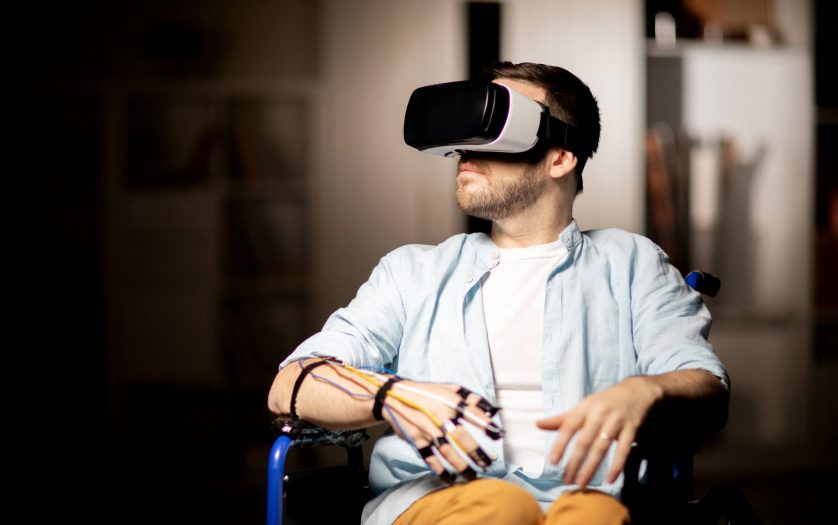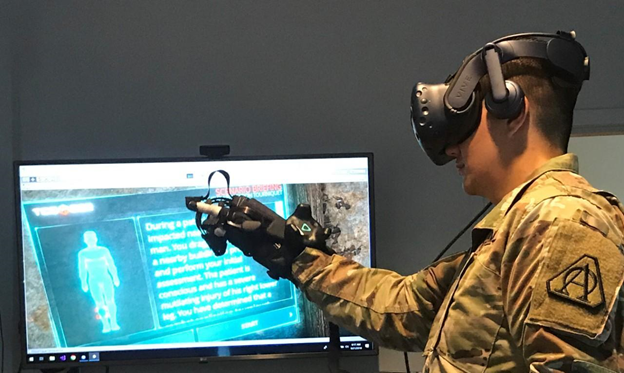This article was extracted from the Recommended Practices for Haptics in Enterprise VR published by the Haptics Industry Forum.
What should be considered while planning to include haptics in a VR assistive solution?
The goals of these use cases are typically to influence or generate a measurable improvement in patient responses to standard measures. Measures can include physiological improvements such as reduced heart rate, anxiety, etc., task-related improvements such as task completion times, error rates, etc., or other miscellaneous measures such as therapy duration.
● Reducing costs. A well-designed VR experience can enable unsupervised training. The virtual training task should be clear and self-explanatory. In that way, multiple patients can train in groups or at home with just the guidance of one physical therapist.
● Increased engagement. VR can help increase the engagement of patients in their therapy. It can be adaptive to the challenge of the patient, providing a challenging but achievable goal. Also, the knowledge of being monitored increases therapy compliance.
● Improved insights. VR therapy can increase the level of insight on progress and performances within the physical rehabilitation process.

What are the key values to adopt a VR assistive solution?
The specific role of haptics varies materially by use case, but generally speaking, it can have the following values:
● Generation of force/resistance for muscular training/rehabilitation use cases. Broadly speaking, increasing the resistance in a training bicycle is a type of haptics; moreover, this can be associated with a virtual reality experience.
● Generation of error feedback for body pose, task progression, or other training/rehabilitation-specific measures. Posture correcting yoga pants (e.g., wearable) in conjunction with a VR yoga class is an example use. Note that the haptic feedback can be automatic or triggered by a coach/trainer in this scenario.
● Generation of increased immersion. Similar to other broad use cases, haptics are known to increase the immersive quality of a virtual reality experience. This can be valuable for training or entertainment-driven assistive use cases. For example, providing content-synchronized feedback for non-ambulatory users (e.g., in a hospital bed) can increase the quality and duration of the engagement.

Why should you include haptics in your VR assistive solution?
Generally speaking, assistive haptic feedback needs to consider these key points:
● Safety. Devices that generate forces on users need to be engineered so that they cannot cause injury due to inadvertent use. For rehabilitation use cases, this consideration is particularly important as users may have non-normal ranges of motion, sensitivity, etc. If possible, users and practitioners should be empowered to reduce/eliminate the haptic feedback in real-time to allow for individual variation.
● Consistency. In order to use haptics to generate precise, measurable outcomes, the haptic feedback must have a maximum amount of consistency both from use to use and from installation to installation. For body-mounted feedback, careful consideration should be paid to fit consistency, including having multiple sizes or specific criteria for appropriate body size considerations.
● Perceptibility. In addition to consistency, haptic feedback needs to both be noticeable and provide the appropriate dynamic range of sensation. This is particularly relevant to error-driven haptic feedback. If the specific use case involves vigorous physical activity, haptic sensations typically need to be stronger but may also need to be carefully designed to disambiguate them from other scenario-related stimuli. Overly complex haptic signaling can increase cognitive load and confusion.
● Expressivity. Haptic devices need to be able to provide a sufficient perceptible range of experience so that users can correctly interpret the stimuli. Basic body-mounted error feedback may only need 1-bit of expressivity (on/off), whereas an error measure that indicates the quantity of the error may require many more bits.
● Wearability. Virtual reality rehabilitation needs to match therapy or reimbursement budgets. The haptics device used for these applications should be easy to wear, comfortable, and should not impede users’ natural movements.
● Embodiment. The ideal haptic device should be transparent while not interacting and perfectly reproduce reality while interacting with VR. The ease of use in putting on and removing is key for rehabilitation. System developers should optimize transparency given their budget constraints.
● Scalability (hours of use, number of deployments, etc.). One of the key aspects to consider when thinking about haptics in VR is the origin of scalability. Do you need repeatability of the same content on different premises (for instance clinical therapy)? Or would you like to target hundreds if not thousands of users (home-based rehabilitation)? Both scenarios have different needs and requirements that can be addressed by different haptics devices.
● Reliability. A haptic system should be reliable. It should always work especially in home-based environments where no specialist is available to debug a potential problem.
Which haptics characteristics should you optimize while designing your content and choosing your haptics device?
● Security. Assistive virtual reality use cases deal with patient data which is a regulated area and requires specific management.
● Cognition. Virtual reality is a technology that might not fit the cognitive state of some patients.

Overview of VR assistive use case
Assistive use cases relate to health and wellness, rehabilitation, and other typically therapeutic or clinical uses to improve patient outcomes. This area is relatively nascent in terms of haptics but does provide some novel considerations relative to the use and value of haptic feedback. Virtual reality technologies are used within rehabilitation processes for impaired patients. Virtual reality is used to target specific movements, or to subject the patient to specific stimuli to accelerate recovery.
In 2020, the United States Defense Health Agency awarded a contract to HaptX and others to develop a haptics-based training system to improve the skills of U.S. Army fighters who administer emergency trauma care on the battlefield. The contract funded HaptX and its partners Engineering & Computer Simulations and Mayo Clinic to integrate the true-contact haptics of HaptX Gloves with the Army’s Tactical Casualty Combat Care (TC3) environment.
For many years, TC3 used VR to teach soldiers to perform airway management, access vascular systems, apply tourniquets, and more. But without realistic touch feedback, trainees were only able to learn abstract procedural steps and were unable to naturally practice key skills and physical interactions. This contract funded research and development to improve the quality and retention of training with the goal of saving more lives on the battlefield.

Customer Goals: Skills transfer, increased training effectiveness
Haptic Technologies Used: The project incorporated multiple HaptX Gloves DK2 systems. These gloves maximize realism by combining high-fidelity tactile feedback which displaces skin up to 2 mm, variable force feedback delivering up to 40lbs of resistive force per hand, and electromagnetic finger tracking.
Role of Haptics: The developers of this project applied haptic effects to the virtual interactions to enable trainees to physically feel and practice the training program’s dexterous manual motions. These interactions included grasping and using supplies, feeling correct locations on the patient’s body, turning the patient’s body, and more. Haptics enabled the developers to achieve the project’s core mission of advancing training through improved manual interfacing with the environment.
Outcome: The Army is midway through the project and will report its findings upon completion. Initial feedback has been positive.
Who is Interhaptics?
Interhaptics is a software company specialized in haptics. Interhaptics provides hand interactions and haptic feedback development and deployment tools for virtual reality (VR), mixed reality (MR), mobile, augmented reality (AR), and console applications. Interhaptics’ mission is to enable the growth of a scalable haptics ecosystem. Interhaptics strives to deliver top-notch development tools for the VR/MR/AR, mobile, and console developer community, and the interoperability of haptics-enabled content across any haptics-enabled platform.

If you are interested in designing high-fidelity haptics or integrating haptic feedback to your virtual reality (VR) project, download Interhaptics Haptics for VR and MR. To collaborate with Interhaptics on your AR/VR/MR project, you can contact us here.






